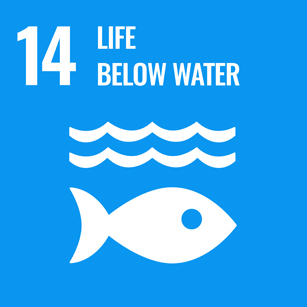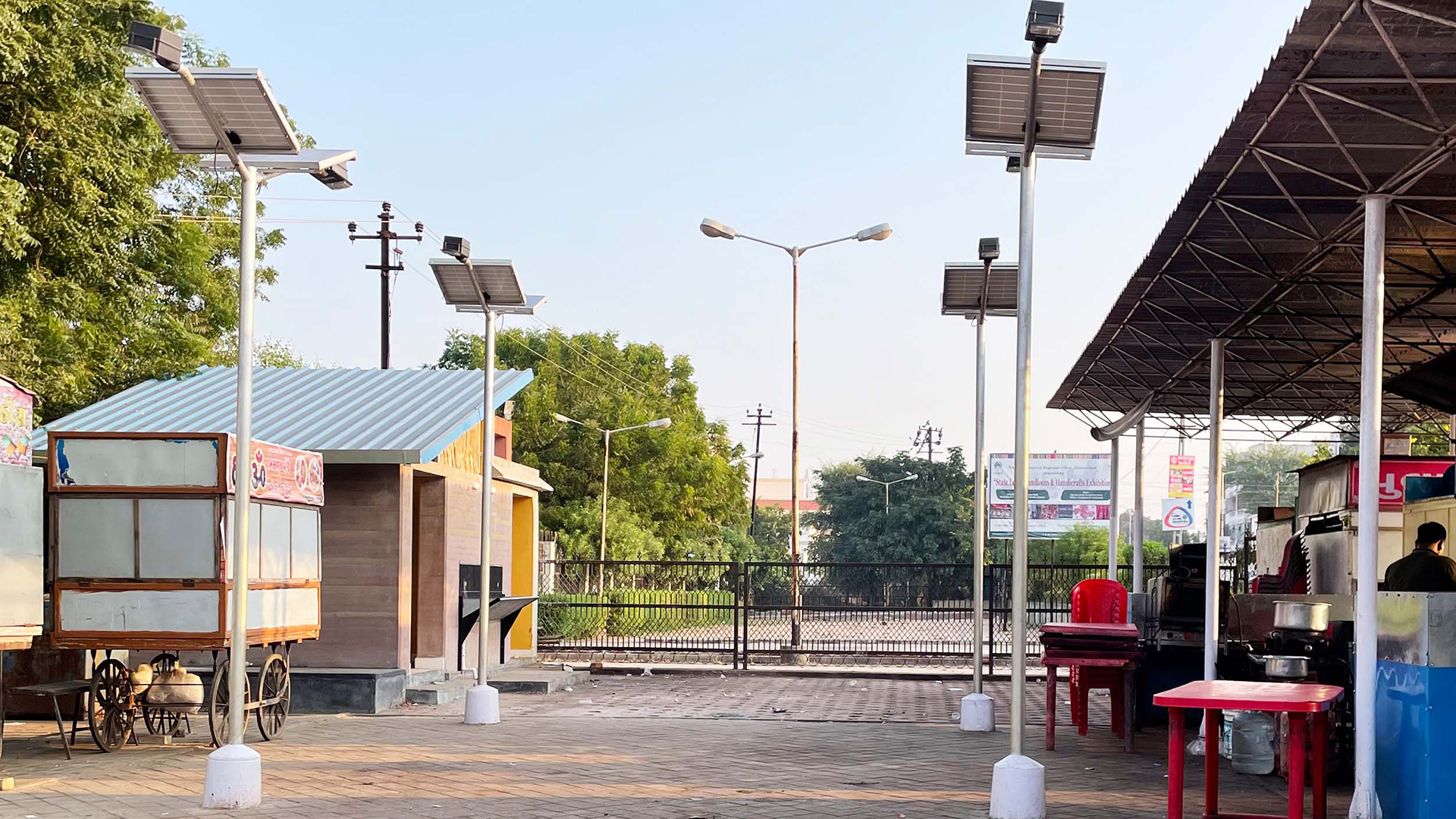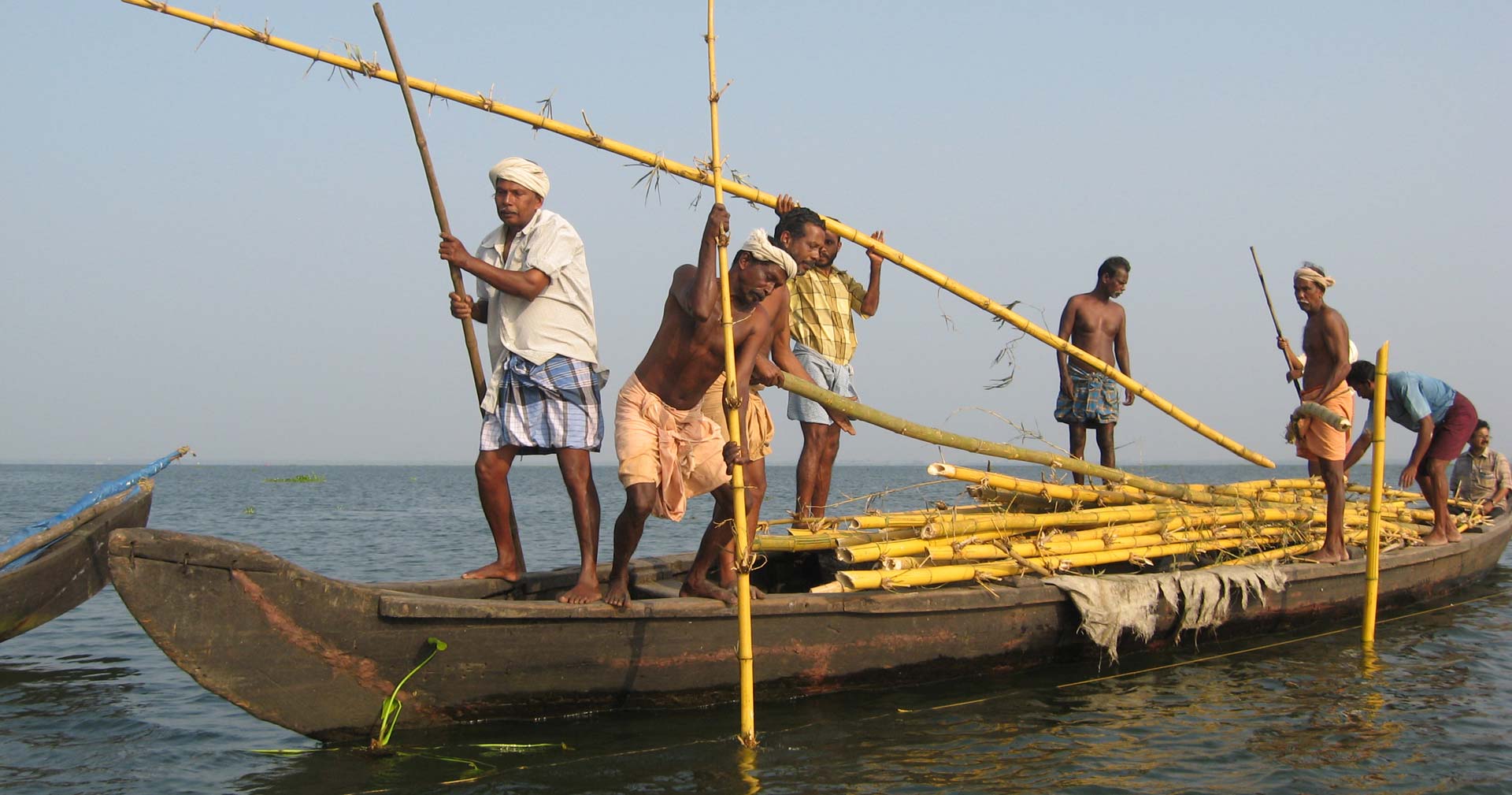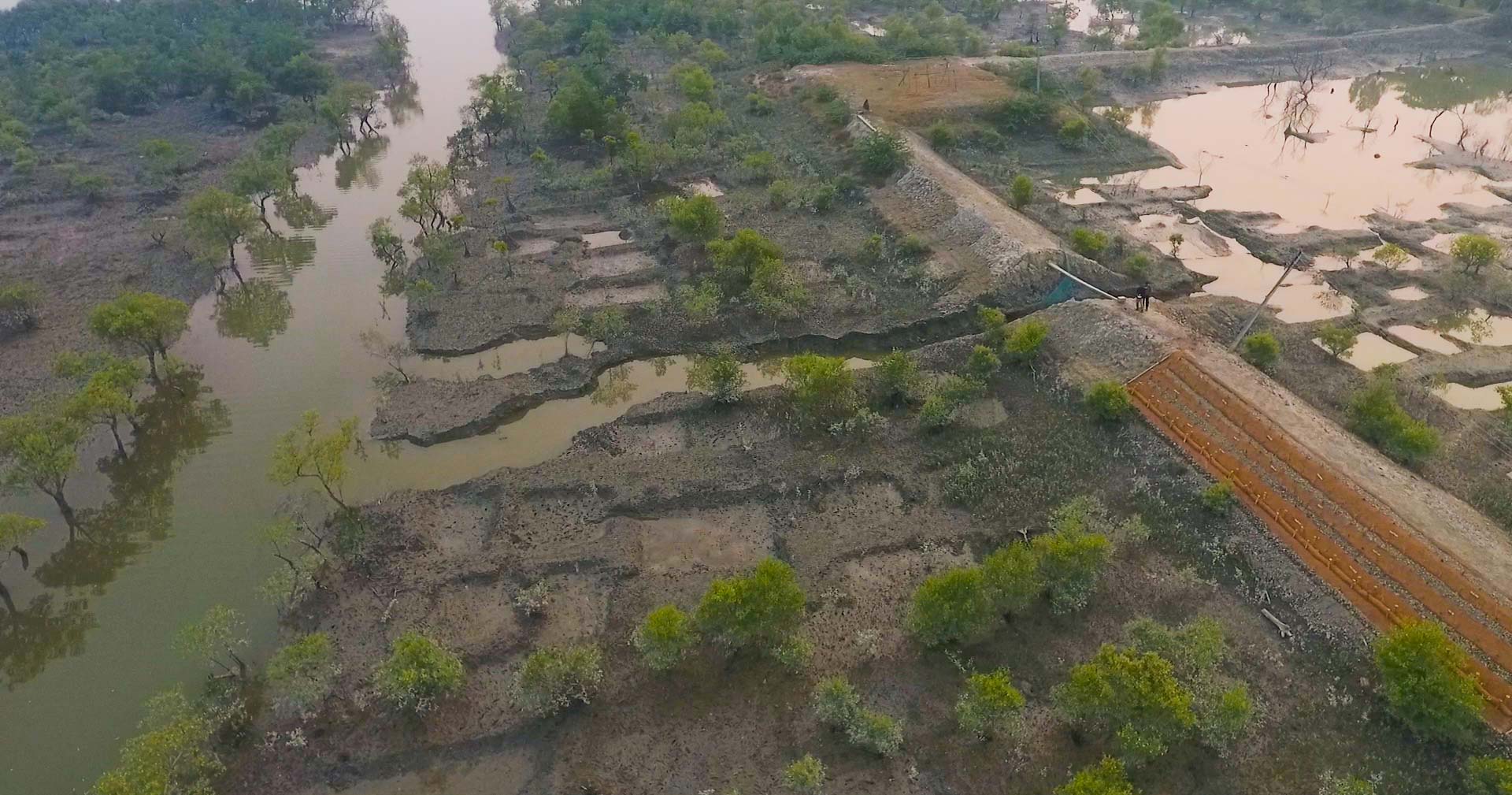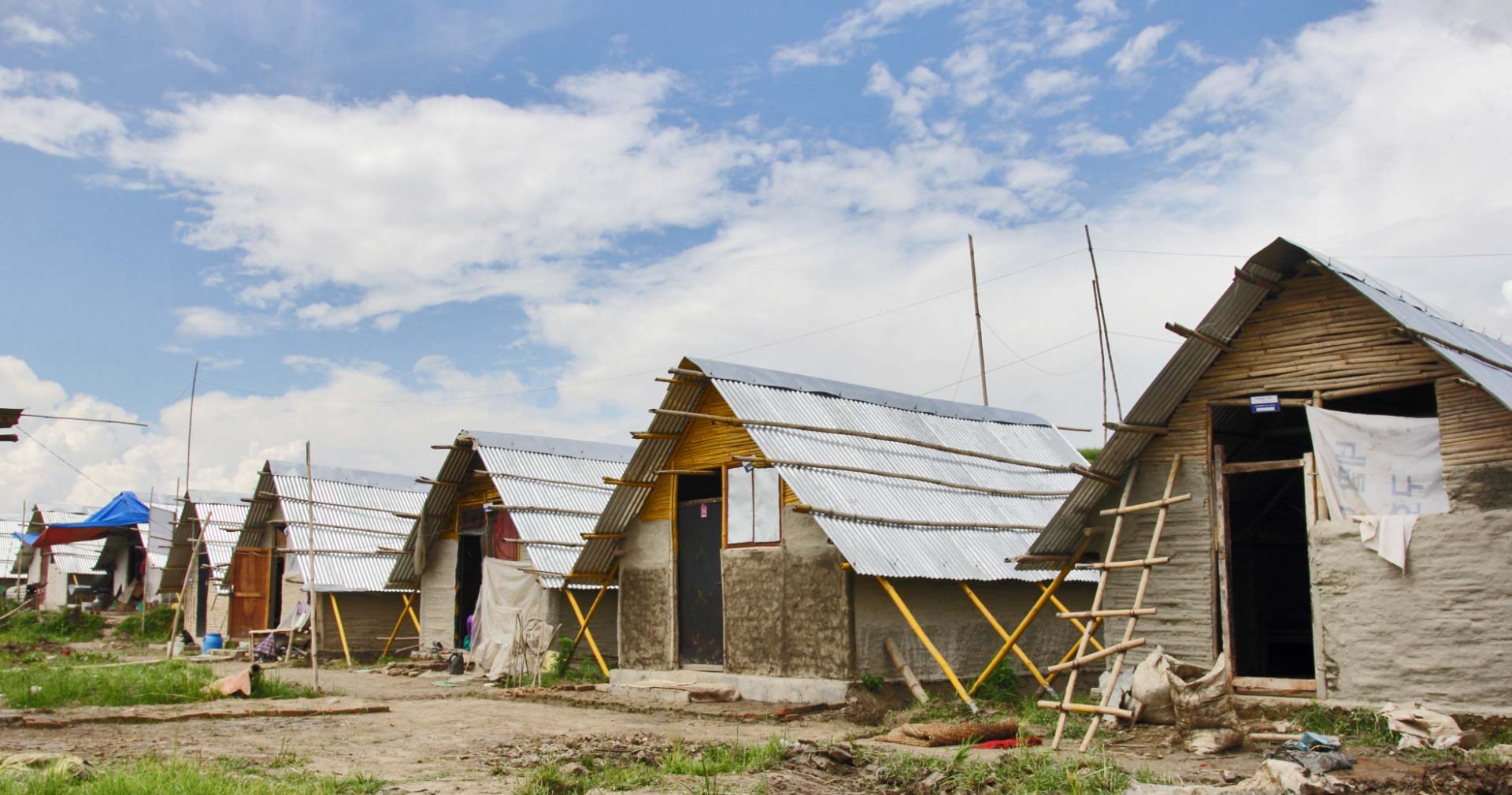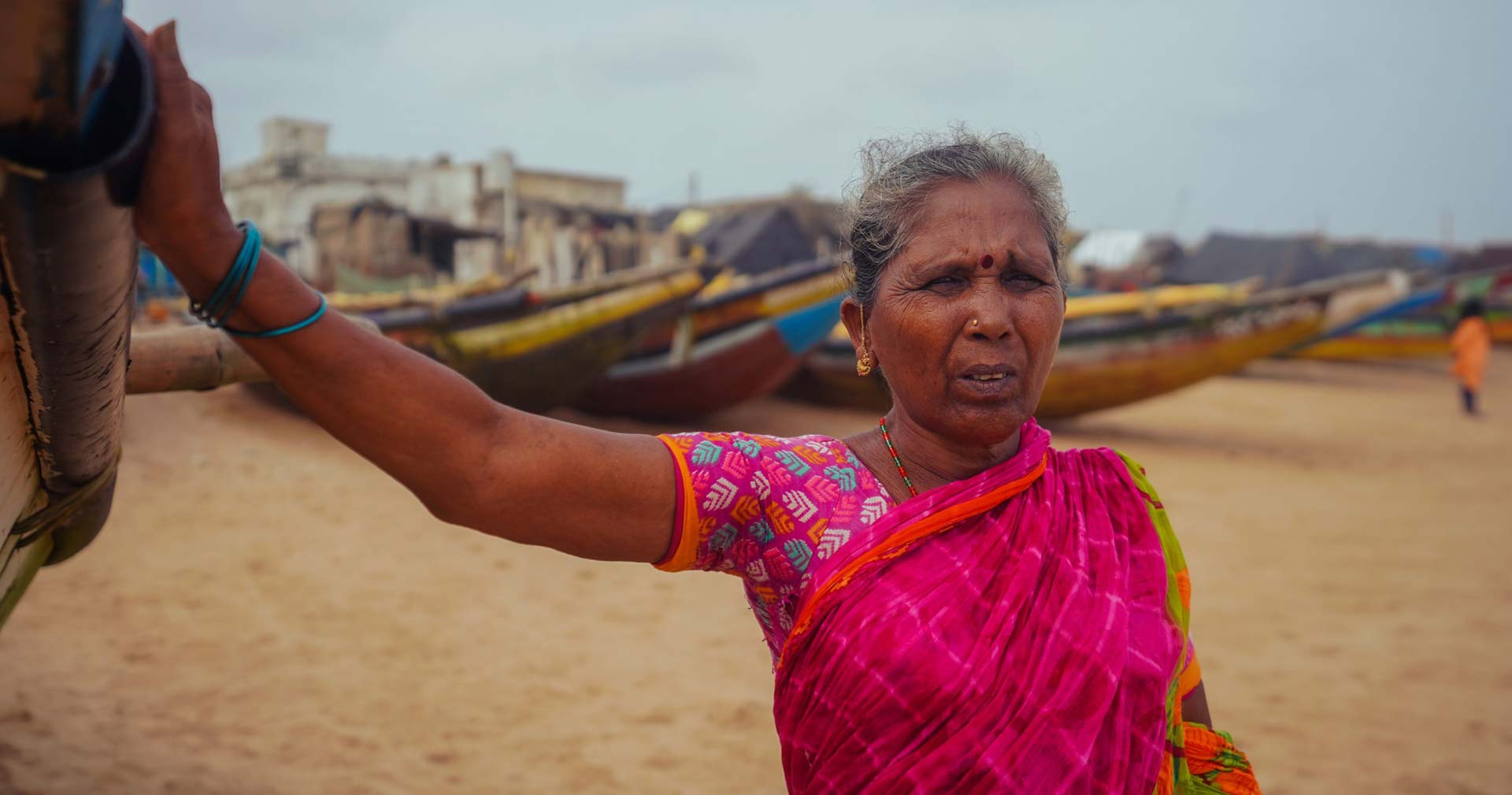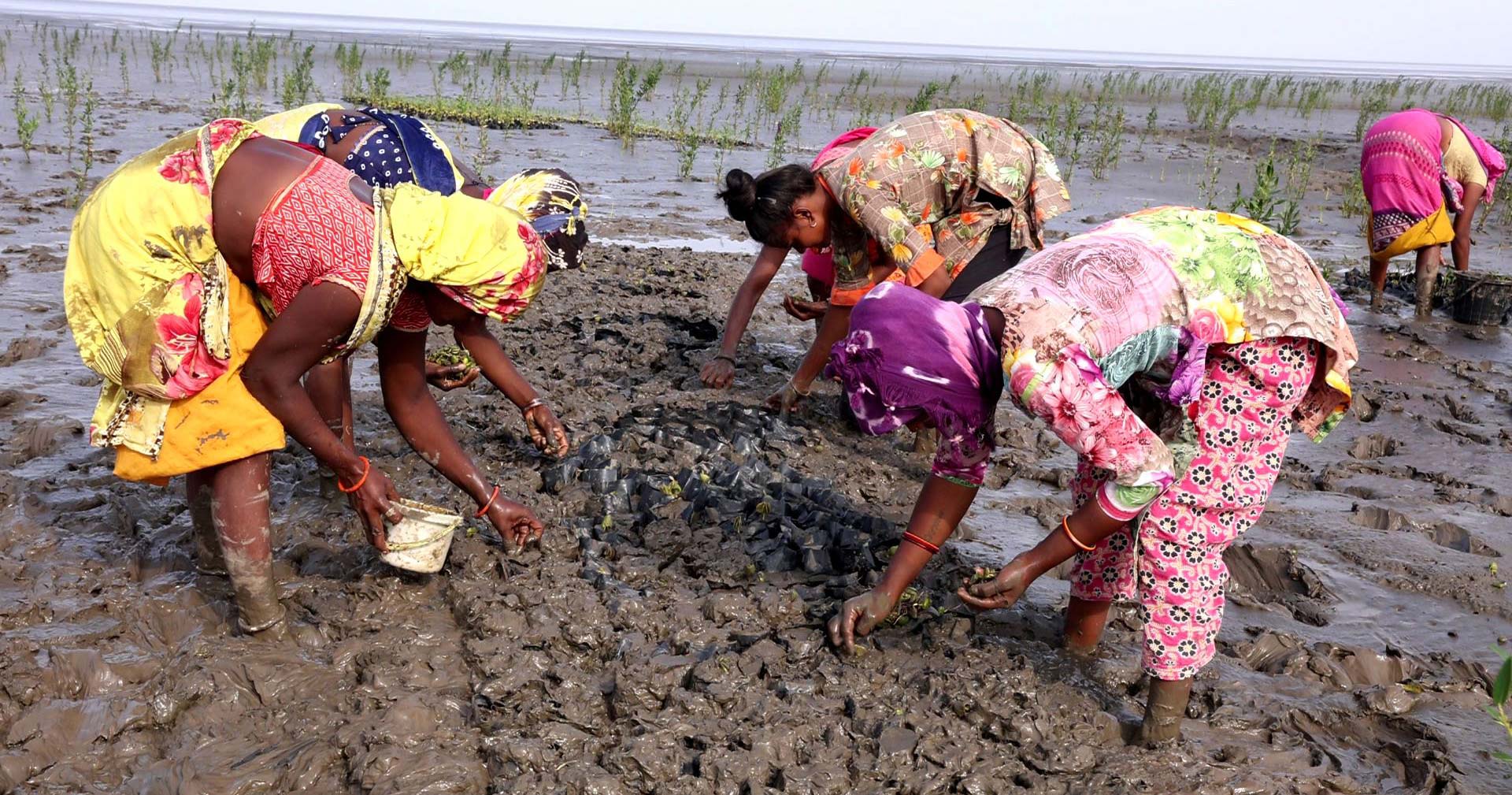Resilience
Climate-related risks like floods, droughts, cyclones, wildfires, extreme temperatures, and more
Home > Solution Areas > Resilience
India is experiencing an increase in the frequency and magnitude of climate-related disasters and extreme weather events, such as floods, droughts, cyclones, heatwaves, and wildfires. In 2019, it was the 7th most vulnerable country to climate change. Such climate-related risks disproportionately impact low-income communities in rural and urban areas, worsening poverty, disrupting access to essential services, damaging property, and aggravating inequalities.
To secure the lives, health, and safety of its inhabitants, India needs climate solutions that build resilience to climate risks, placing vulnerable groups such as low-income communities, women and children, farming and fishing communities and others dependent on subsistence means of livelihood and climate-sensitive sectors, at the centre.
Challenge
The impacts of climate change vary with India’s diverse topography and exacerbate a multitude of physical risks. These include hydro-meteorological disasters (floods, droughts, cyclones, heat waves, cold waves, avalanches), glacial lake outbursts and landslides in mountainous regions, wildfires, sea level rise, erratic rainfall, and more.
Over 75% of India’s districts are extreme weather hotspots; vulnerable to floods, droughts, and cyclones. Climate change is increasing the incidence of floods due to unpredictable, high-intensity rainfall; over 91% of India’s flood-exposed districts are vulnerable to extreme floods today. Inundation and waterlogging are aggravated by poorly planned settlements, encroachment of water bodies, and unsustainable land use change. Over 70% of India’s drought-exposed districts are vulnerable to extreme droughts (meteorological, hydrological, or agricultural), due to short or erratic monsoons, over-exploitation of groundwater levels, and poor water conservation, or poor cropping and agronomic practices, among other factors. Climate change is also altering the vulnerability landscape – extreme drought-prone areas are now also susceptible to floods and/or cyclones. Similarly, while the east coast of India has traditionally experienced extreme cyclones, the west coast is seeing an increased intensity and frequency of cyclones due to climate change, and over 85% of India’s cyclone-exposed districts are now prone to extreme cyclones. India’s hotspot districts are thus increasingly susceptible to more than one hydro-meteorological disaster, adding to climate risk uncertainties in forecasting.
In addition, India is at risk of breaking the human survivability limit for heat, which could negatively impact the health and productivity of the 380 million people (75% of India’s workforce) dependent on heat-exposed labor as well as those living in poor informal settlements. The increasing frequency of heatwaves could halt or even reverse progress on income and food security, gender equality, and poverty; this is particularly concerning for metropolitan areas, estimated to house 675 million people by 2035, which are prone to the urban heat island effect. Furthermore, wildfires are getting bigger and hotter as landscapes get drier, while heavy rainfall and poor water retention by soil are increasing the incidence of landslides in hilly terrains. Rapid glacier retreat in the Himalayas is also increasing the threat of glacial lake outbursts and flash floods.
While the factors increasing exposure to these risks vary, a key driver across several risks is change in land-use/land cover (LULC) such as deforestation, reduced forest cover, and unsustainable agriculture. This contributes to micro-climatic changes, further aggravating the intensity and frequency of risks.
The impacts of these diverse risks are severe. Sudden-onset events like floods, cyclones, and wildfires result in widespread destruction to property, natural ecosystems and biodiversity; loss of human and animal lives; and disruption of access to energy, water, and food. Slow-onset events like droughts also result in deterioration of soil health, depleted water levels, low agricultural production, high human and livestock mortality, malnutrition/starvation; sea level rise leads to increased soil salinity, destruction of property, and forced retreat inland; and heat waves and heat stress have deleterious impacts on health and economic productivity.
Accompanying negative social and economic impacts across several risks include:
- loss of livelihoods;
- income reduction and higher indebtedness;
- climate-induced temporary displacement or permanent migration;
- disruption of essential services like education, healthcare, and quality nutrition; and
- spread of infectious/vector-borne diseases and lower immunity.
Although not attributed only to climate change, India experienced extreme weather events on 314 days in 2022, claiming at least 3,026 human lives and 69,899 animals, affecting at least 1.96 million hectares of crop area, and destroying over 423,249 houses. Floods and storms alone caused USD 7.6 billion in economic damages in 2021, and climate-induced loss and damage are likely to increase as the planet warms.
Climate change disproportionately exacerbates risks for those communities who are already facing multi-dimensional socio-economic challenges, whether it is gender inequality, poverty, food insecurity, or conflict. Women and the elderly are worst affected; they bear the brunt of climate shocks and are subject to further drudgery and safety risks when faced with forced migration or displacement. Low-income communities dependent on subsistence-based livelihoods are pushed into debt traps when disasters hit, unable to recover due to a lack of viable livelihood/relocation alternatives, damage to property, and a lack of disaster insurance.
These problems demand strong and urgent climate resilience for India’s most vulnerable. However, building resilience to these risks, through improved disaster preparedness and response, faces several challenges in India. Existing response strategies are episodic and are often missing local context, and due to slew of factors, the implementation of local disaster management plans can be inefficient. Consulting local communities is a crucial foundation for effective risk governance under the Sendai Framework for Disaster Risk Reduction, but they are often excluded from decision-making and planning. There is also a lack of information and awareness of micro-climate risks, due to an absence of granular data, hindering accurate forecasting and early warnings. Further, as development is often not informed by local climate risks, new development poses added risks for residents if approached in an unsustainable manner. Such development can also pose a threat to natural ecosystems and undervalue the significance of nature-based solutions for disaster risk reduction. Finally, loss and damage assessment does not account for all losses, including non-economic losses, and a lack of holistic data makes it difficult to provide effective disaster insurance, compensation, or relief measures – further impoverishing affected communities.
Solution
Climate resilience includes a crucial component of adapting to climate change impacts with growing awareness about climate risks, along with disaster risk reduction and preparedness, with the aim to secure lives, property, and opportunities for communities in disaster-prone areas.
Secure lives and property in
disaster-prone areas
Increase community awareness
about climate risks
Improve disaster risk reduction, preparedness, and response
Range of responses


- Localised risk and micro-climate vulnerability assessments at sub-district, district, and taluka levels;
- Increased use of spatial data (GIS modelling/remote sensing), aerial surveys, and Artificial Intelligence to evaluate climate hazards and improve forecasting (such as mapping of wildfire-prone areas, or predictive risk modelling for droughts, cyclones, and heatwaves);
- Local wireless early warning systems combined with alert systems embedded within social media and mobile networks, or early warning mobile applications;
- Dissemination of weather-based advisories or forecasting in regional languages on real-time basis, through community-run radio stations;
- Micro-Automatic Weather Stations that offer automated weather predictions to save human labour and improve accurate forecasting in remote areas, through frequent and local readings
- Digital platforms/applications to capture real-time loss and damage directly from affected individuals and communities, combined with social media/online data and aerial surveys, and supplement information available to government authorities and financial institutions.
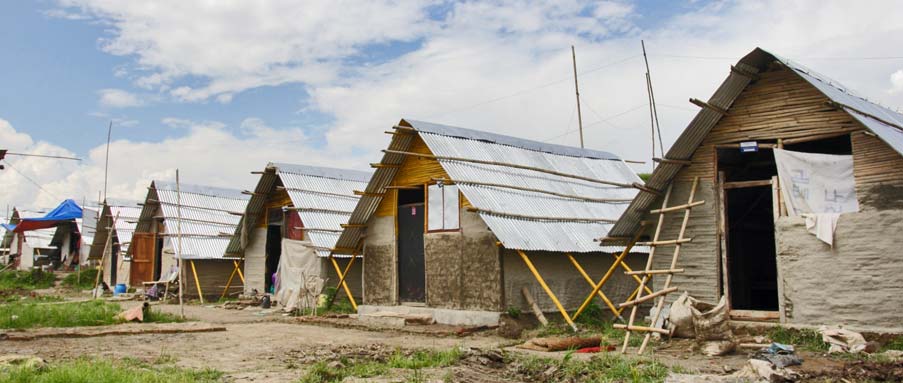

- Building climate-friendly housing across heat hotspots, such as modern mud houses/bamboo houses and promoting cool roofs (using solar-reflective white paint, mosaic, membrane, or coconut husk/paper waste layer);
- Increasing access to water by repairing tubes, wells; reviving community rainwater harvesting structures; building public drinking fountains;
- Establishing public shelters or cooling centres, especially for the most vulnerable groups (women, elderly, migrant workers, street vendors, etc.);
- Constructing hard coastal protection measures like bio-dykes or embankments to guard against sea level rise and floods;
- Regularly clearing natural or engineered drains of silt and solid waste;
- Constructing and maintaining disability-friendly multi-purpose flood/cyclone shelters that are accessible via good roads, integrated with rainwater harvesting/storage tanks and solar panels to secure energy and water access, and can accommodate livestock;
- Building flood-resilient/cyclone-resilient/multi-hazard resilient housing, for example, on raised plinths/platform, with stronger housing material (bricks instead of mud to survive strong winds and floods), combined with materials like jute/bamboo that are easy to replace or dismantle; and reinforced with concrete stumps to make them sturdy;
- Developing climate-resilient infrastructure standards;
- Constructing artificial glaciers to secure water supply in the Himalayan regions.


- Enhancing green and blue cover to combat heat stress, restoring and rejuvenating water bodies, growing peri-urban gardens/forests, using green roofs;
- Restoring mangroves, and coastal ecosystems, and leveraging coastal bio-shields to safeguard against cyclones and sea level rise by reducing wave energy and storm surges;
- Promoting sustainable afforestation, fortifying houses/settlements with water-thirsty/resistant plants (bamboo, banana) to prevent soil erosion and soak up excess flood water.
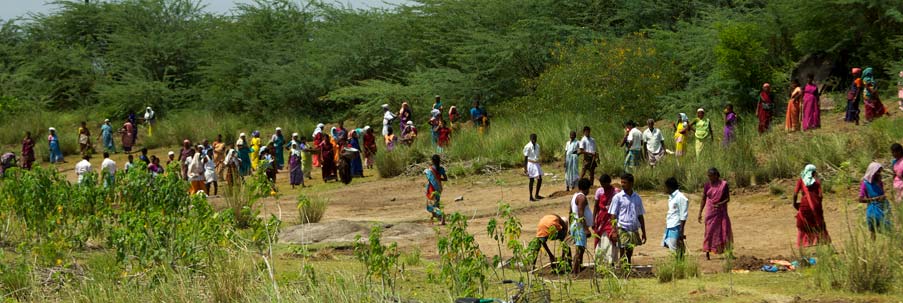

- Developing disaster risk reduction plans for the most vulnerable hotspots and populations, through heat action plans or flood management plans;
- Developing community-based strategies for natural resource management (such as for urban rivers/forests) in consultation with local authorities;
- Creating hyper-local contingency plans at all levels that identify at-risk areas and incorporate access to food, water, energy and healthcare;
- Preparing risk monitoring checklists or setting up decentralised risk monitoring platforms/committees, especially for slow-onset events like drought, and training panchayats or community leaders to monitor the indices;
- Training community members with well-defined roles and responsibilities to devise and implement community-based early warning systems.
- Training local women or healthcare workers like ASHA workers and Anganwadi workers to disseminate information about local climate risks and contingency plans, especially to vulnerable groups, and identify and respond to health risks that are exacerbated by climate change, including heat stress related illnesses and vector-borne diseases;
- Increasing public dissemination of information about local climate risks, through public announcements, live hoardings, digital modules, etc.;
- Implementing targeted awareness campaigns for vulnerable groups, including door-to-door or at health centres for women, and at schools for children;
- Implementing awareness campaigns regarding beneficial climate-adaptive lifestyle/work behaviours, such as shifting work schedules, increasing access to shade and water, and implementing rest breaks for heat-exposed workers.
- Providing disaster insurance or loss and damage compensation/finance based on real-time assessment of impacts;
- Providing just-in-time or anticipatory cash transfers to households in climate hotspots on the notification of an impending disaster or when key indices are triggered, to aid preparedness and response;
- Creating a disaster and early warning fund to ensure timely and immediate response for affected communities.
Target groups
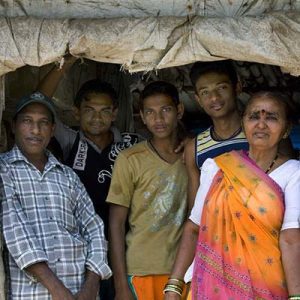

Low income communities


Women
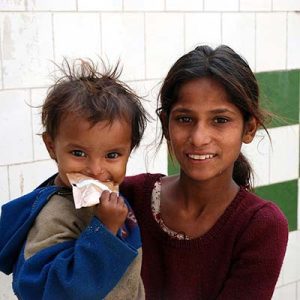

Children
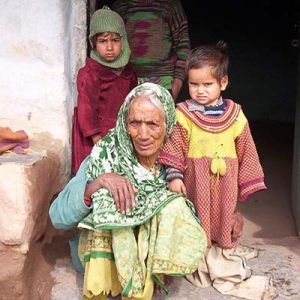

Elderly


Migrant workers/labourers
UN Sustainable Development Goals
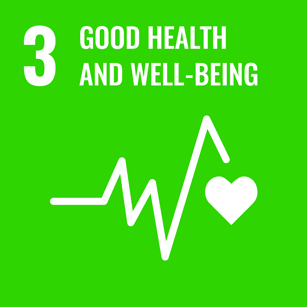

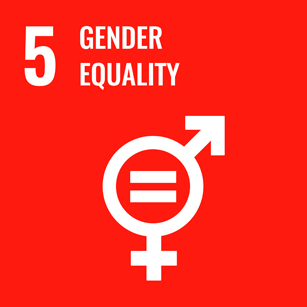

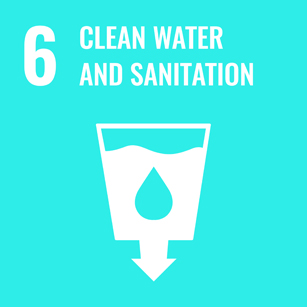







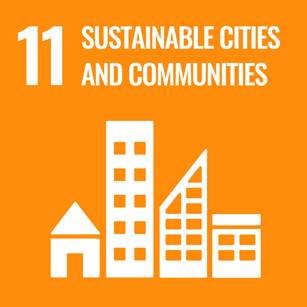



Key considerations
Design and implement climate solutions based on local risks
Solutions must be context-specific, with activities attuned to community needs and local environmental contexts. A profiling of local-level climate risks must be the starting point for every project; this can be supplemented with secondary data such as CEEW’s Climate Vulnerability Index or State Action Plans on Climate Change (SAPCCs) to assess the degree of vulnerability. Further, place-based vulnerability assessments, covering social, economic, environmental, institutional and governance factors, and integrating the local community’s perception of risks, can help ground truth secondary vulnerability data.
Leverage indigenous knowledge systems to build solutions
Solutions must be bottom-up and people-centered. Indigenous knowledge and local community wisdom must be taken into consideration while designing adaptation and resilience solutions, and to address maladaptation, using tools like CRiSTAL (Community-based Risk Screening Tool – Adaptation and Livelihoods) or WOTR’s CoDrIVE.
Prioritise disaster preparedness to save lives and money
Instead of only providing resources for emergency response after a natural hazard has occurred, funders must invest in understanding local climate risks and help communities prepare for pre-emptive and early action. Disaster preparedness and disaster risk reduction (DRR) are cost-effective and save lives and resources required for aid/response; for example, every dollar invested in DRR can result in savings of USD 3 to 15 in disaster losses.
Prioritise nature-based solutions to address climate risks
Nature-based solutions must be prioritised in addressing climate risks. As a blend of grey and green infrastructure typically provides the greatest resilience, grey infrastructure can be embedded with green infrastructure, with the aim of moving towards green solutions. For example, modular roofs are a low-cost solution to heat in urban areas, which can over time be replaced or combined with green roofs as they become more universal and affordable; biomaterials (including locally available ones like mud, straw, etc.) can also replace traditional raw materials for infrastructure. Cultural preferences of people for spatial design in different parts of a state, and local availability of materials must also be accounted for while choosing building materials. In many cases, nature-based solutions can also be layered with a livelihoods approach, to generate local employment and engage local communities.
Build resilience through inclusive MEL frameworks
The uncertain context of climate risk management often hinders standard indicators and universal metrics for measurement, evaluation, and learning (MEL). MEL frameworks developed should be people-based, informed by foundational principles such as impact, quality, ownership, complementarity, and equity (like the InsuResilience Pro-Poor Principles), and gradually build resilience to climate change.
Resilience - Projects
Street vendors encounter substantial climate-related risks, including heatwaves, pollution, and waterlogging, directly impacting their livelihoods. These risks lead to shorter working hours, health problems, and the loss of perishable goods, jeopardising their income and overall means of living.
Hunnarshala Foundation’s project aims to build the resilience of 400 street vendors in the city of Bhuj, in Kutch District, Gujarat by introducing climate-resilient infrastructure in six street vending zones across the city. The project not only focuses on implementing street vending zones and providing essential services in accordance with the Street Vendors Act (SVA), 2014 but also aims to use low-carbon, climate-resilient materials, innovations, and techniques for the infrastructure.
To ensure inclusivity and ownership in the implementation process, the project follows a participatory approach, involving stakeholders, including street vendors. It also has a provision for capacity building for the street vendors to effectively implement, operate, and maintain the climate-resilient infrastructure.
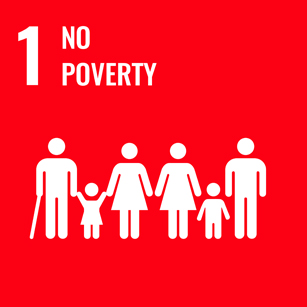



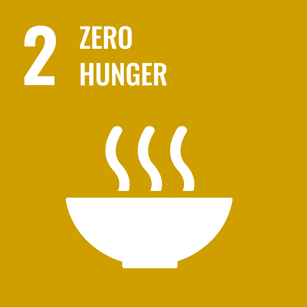










In India, the frequency of extreme weather events and disasters, exacerbated by climate change, is steadily increasing each year, especially in states like Kerala. The intensity and frequency of these events are projected to escalate further in the near future, posing an elevated risk to vulnerable communities and exposing them to the devastating impacts of climate-related catastrophes. While the consequences of such climate disasters can be far-reaching and affect everyone, the vulnerability of each community varies. Communities residing in areas below mean sea level (MSL) are particularly susceptible to the immediate and slow-onset effects of these events. Kuttanad, located in the Alappuzha district of Kerala, is one such low-lying region that suffered significant damage during the devastating floods in 2018, resulting in substantial loss of life and property. The lack of timely and tailored disaster preparedness and mitigation plans exacerbated the severe consequences faced by the affected communities.
To address this issue, ATREE aims to establish ward-based Disaster Prepared Gram Sabhas (DPGSs) through its Community and Environment and Resource Centre (CERC) in Allapuzha. These Gram Sabhas will educate communities about climate and disaster preparedness, enabling them to respond quickly and better cope with disasters. The initiative builds upon a pilot disaster preparedness program and an area-specific mitigation plan implemented by ATREE to enhance the resilience and adaptation of communities in the district. The proposed project seeks to expand this initiative to two Gram Panchayats, namely Nedumudi and Kainakary, with the collaboration of different levels of government machinery. Additionally, the project will incorporate mobile applications to disseminate weather and climate information early, provide training to last-mile workers such as ASHA, and establish a disaster management team (DMT) and rapid response team (RRT).











India’s extensive coastline faces numerous threats from anthropogenic activities, including increased vulnerability to extreme climate events like cyclones and the impact of sea level rise due to climate change, which is exacerbating degradation caused by saltwater intrusion. Among the affected areas, India’s eastern coast, particularly the Sundarbans, the world’s largest contiguous mangrove forest, is highly susceptible to these natural and climate-induced impacts. Recurrent cyclones have led to a decline in mangrove cover, significantly damaging this fragile ecosystem. Moreover, anthropogenic pressures such as over-fishing and settlements pose additional risks to the Sundarbans.
To address these critical threats, Sustainable Environment and Ecological Development Society (SEEDS) has been actively working in the region to restore mangrove ecosystems to enhance the resilience of forest fringe communities and provide them with alternative livelihood opportunities. Mangrove plantations are crucial in reducing wind speeds, limiting saltwater intrusion, preserving biodiversity, and sequestering carbon dioxide, contributing to climate change mitigation and adaptation efforts. Additionally, the use of vetiver grass helps prevent soil erosion and maintain land integrity, which is essential for protecting the coastline and surrounding ecosystems.
Building on previous learnings and long-term experience in the region, SEEDS plans to expand the project to new locations within the Sundarbans. The project also places significant emphasis on improving livelihood opportunities for local communities. This includes training self-help groups in producing marketable items like handicrafts, furniture, or essential oils. Furthermore, SEEDS aims to establish nurseries for mangrove saplings and promote beekeeping for honey production, thereby providing sustainable income sources for the communities.
Through these integrated efforts, SEEDS seeks to restore and conserve the Sundarbans mangrove ecosystem while improving local communities’ socio-economic well-being. This holistic approach to conservation, climate action and livelihood development is essential for achieving long-term resilience and sustainable development in the region.







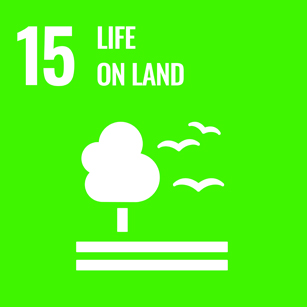



The increasing frequency and severity of extreme weather events and disasters in India, exacerbated by climate change, damages and destroys thousands of homes each year. The intensity and frequency of such extreme events are projected to only increase in the near future, thus exposing the vulnerability of communities to the devastating impacts of climate-related catastrophes. The issue is compounded by the use of sub-standard construction materials, which compromises the structural integrity of buildings and heightens the risks faced by communities, particularly in disaster-prone areas.
As India grapples with the urgent need for infrastructure development, the challenge lies in balancing the essential nature of housing with the imperative need to build resilience to the impacts of climate change, as well as mitigating greenhouse gas (GHG) emissions. Therefore, a comprehensive approach is required to address the housing needs of the most affected communities and integrate climate resilience, sustainable materials, and community empowerment into the equation.
In this context, Sustainable Environment and Ecological Development Society (SEEDS) proposes establishing a scalable model for low-carbon, climate-resilient housing in highly vulnerable climate zones. This model entails either rebuilding or retrofitting the homes of the most vulnerable populations, utilising sustainable materials. The project also encompasses the development of replicable approaches to expand the impact of resilient housing initiatives across various regions, facilitated by a central hub. This hub will consist of a prototype house constructed from climate-resilient materials; a marketplace offering locally available, sustainable, and quality materials; and a training center.
The project aims to enhance the availability and affordability of suitable materials for climate-resilient housing by leveraging local resources and promoting traditional building practices. It also aims to facilitate access to financial and technical assistance for procuring such materials. Recognising the significance of increasing community knowledge regarding sustainable construction materials and technologies in the context of disaster resilience, the project seeks to empower communities to make informed decisions regarding their housing needs through education and awareness initiatives.
By actively involving communities in the design, construction, and maintenance processes of their houses, the project aims to enhance community resilience to the impacts of climate change while fostering a sense of ownership and pride in their housing infrastructure.















Climate change is causing an increase in the frequency and severity of extreme events like heatwaves, floods, and droughts. These events pose significant threats to human life, natural landscapes, crops, and both urban and rural infrastructure. Unfortunately, many communities residing in disaster-prone areas lack access to information about such occurrences, making it difficult for them to gauge the exact level of impending risk from standard warnings. This limitation hampers their ability to take proactive action.
To address this issue, Sustainable Environment and Ecological Development Society (SEEDS), in collaboration with Microsoft and technology partner Gramener, has developed a unique artificial intelligence-based risk assessment solution. This solution generates hyper-local risk information on climate-related disasters, such as floods, droughts, cyclones, and non-climatic disasters like earthquakes, that can be used as early warnings for impending disasters. By utilising high-resolution satellite imagery and open-source datasets, the system identifies regions that are socio-economically vulnerable to generate targeted advisories to these communities to avoid immediate losses and recommend actions to provide pre-emptive refuge to people. Additionally, the solution recommends pre-emptive refuge options for people in need.
The primary objective of this project is to support governments, disaster response authorities, and frontline aid organisations in formulating risk-averse strategies to tackle the exacerbating climate emergencies and disasters. The proposed project will continue to work in geographies focused on in the previous phases including parts of Maharashtra, Odisha and Delhi, and the AI-based solution will be introduced into a new geography in Uttarakhand.















Human-induced climate change is increasing the occurrence of extreme events in India, impacting the lives and livelihoods of millions. Gujarat, situated along India’s western coast, is particularly vulnerable to hydro-meteorological hazards such as droughts, floods, cyclones, and associated ramifications. In fact, 12 out of the 16 coastal districts in Gujarat have been identified as hotspots for tropical cyclones. As climate change persists, with rising ocean temperatures and sea-level rise, the frequency and intensity of these cyclones are expected to increase further.
Furthermore, the coastal communities in Gujarat are heavily dependent on low-return occupations that rely on natural resources, perpetuating a cycle of poverty and debt. Since 1978, VIKAS Centre for Development, an organisation dedicated to improving the quality of life for marginalised communities, has been working to address these challenges. Over time, VIKAS has observed that climate change-induced changes, including rising sea levels, salinity intrusion, and soil erosion, have exacerbated the degradation of natural resources, further compromising the fragile livelihoods of these communities. Consequently, there is an urgent need to mitigate climate risks and enhance the adaptive capacities of both the natural environment and human systems in the region. In response, VIKAS has prioritised harnessing the potential of nature-based solutions.
Since the 1990s, VIKAS has actively engaged in mangrove restoration efforts in the region. In 2016, VIKAS launched the bio-shield initiative as a pilot project, implementing multi-layered plantations of mangroves and other plants suited to saline habitats, aiming to mitigate and adapt to the effects of climate change in Jambusar district, Bharuch. Building on the success of this initiative, VIKAS plans to expand the project by establishing bio-shield plantations across 200 hectares. This expansion aligns with the organisation’s broader Great Green Wall of Gujarat initiative, covering 23 coastal talukas in South and Central Gujarat, as well as the Kachchh and Saurashtra regions. The project’s primary objectives encompass mitigating and adapting to climate change, conserving biodiversity, and enhancing the livelihoods of individuals engaged in fisheries, livestock, and agriculture.













